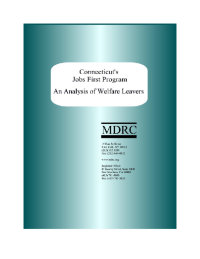Connecticut's Jobs First Program
An Analysis of Welfare Leavers
This report provides data on families who have left cash assistance in Connecticut. The report was produced by the Manpower Demonstration Research Corporation (MDRC), which is conducting a large-scale evaluation of Jobs First, Connecticut’s welfare reform initiative, under a contract with the state’s Department of Social Services (DSS). Other reports issued by MDRC have described the implementation of Jobs First, its impacts on employment and welfare outcomes, and the circumstances of families who left welfare because of Jobs First’s 21-month time limit on cash assistance receipt.
This report focuses mainly on people who entered the Jobs First evaluation when they were applying for or receiving cash assistance in the Manchester and New Haven DSS offices between January and June 1996, and who left cash assistance at some point within 18 months after entering the study (before reaching the 21-month time limit).
Many of the outcomes for welfare leavers in Connecticut are shaped by the state’s unusual financial work incentive, which allows working cash assistance recipients to retain their entire welfare grant as long as their earnings are below the federal poverty level. This generous policy, known as an earned income disregard, means that many of the cash assistance recipients who find jobs remain on welfare at least for a time, and thus do not become welfare leavers.
About half of the welfare leavers were employed in the immediate post-welfare period. This rate is fairly low compared to the rates found in similar studies in other states, presumably because of the enhanced disregard. In other states, a greater proportion of those who find jobs become welfare leavers whereas, in Connecticut, they are more likely to remain on welfare. A positive side-effect of the disregard is that the leavers who are employed have relatively higher earnings, averaging around $3,400 per quarter. Again, this is because people with earnings below the poverty level are likely to remain on welfare.
About one-fourth of those who left welfare returned to cash assistance within one year after leaving. This rate is somewhat lower than in other states, possibly because the individuals who left welfare for work in Connecticut had fairly good-paying jobs. Less than one-third of the welfare leavers received Food Stamps after leaving welfare; however, no data are available on what proportion of these families were actually eligible for Food Stamps.
In a survey conducted 18 months after people entered the study, respondents who were off welfare when interviewed reported average monthly household income of just over $1,500. Just over 70 percent had health insurance, usually through Medicaid. A little less than half reported that they owned a car. In general, it appeared that non-working leavers were worse off than working leavers, although only a small number of non-working leavers were interviewed.
Finally, the report briefly compares individuals who left welfare due to the 21-month time limit with those who left welfare before reaching the time limit, finding that the time-limit leavers had a much higher rate of employment. This is because of the way Connecticut’s time limit is implemented: for the most part, recipients who reach the time limit without employment are granted at least one six-month extension of their benefits; thus, most of the people whose benefits are canceled at the time limit are employed.






